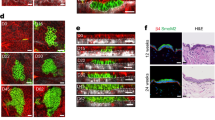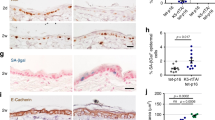Abstract
WNT signalling orchestrates a number of developmental programs1,2,3. In response to this stimulus, cytoplasmic β-catenin (encoded by CTNNB1 ) is stabilized, enabling downstream transcriptional activation by members of the LEF/TCF family4,5. One of the target genes for β-catenin/TCF encodes c-MYC, explaining why constitutive activation of the WNT pathway can lead to cancer, particularly in the colon6. Most colon cancers arise from mutations in the gene encoding adenomatous polyposis coli (APC), a protein required for ubiquitin-mediated degradation of β-catenin7, but a small percentage of colon and some other cancers harbour β-catenin–stabilizing mutations (refs 8,9,10,11, 12,13,14,15,16, 17). Recently, we discovered that transgenic mice expressing an activated β-catenin are predisposed to developing skin tumours resembling pilomatricomas18. Given that the skin of these adult mice also exhibits signs of de novo hair-follicle morphogenesis, we wondered whether human pilomatricomas might originate from hair matrix cells and whether they might possess β-catenin–stabilizing mutations. Here, we explore the cell origin and aetiology of this common human skin tumour. We found nuclear LEF-1 in the dividing tumour cells, providing biochemical evidence that pilomatricomas are derived from hair matrix cells. At least 75% of these tumours possess mutations affecting the amino-terminal segment, normally involved in phosphorylation-dependent, ubiquitin-mediated degradation of the protein. This percentage of CTNNB1 mutations is greater than in all other human tumours examined thus far, and directly implicates β-catenin/LEF misregulation as the major cause of hair matrix cell tumorigenesis in humans.
This is a preview of subscription content, access via your institution
Access options
Subscribe to this journal
Receive 12 print issues and online access
$209.00 per year
only $17.42 per issue
Buy this article
- Purchase on Springer Link
- Instant access to full article PDF
Prices may be subject to local taxes which are calculated during checkout





Similar content being viewed by others
References
Miller, J.R. & Moon, R.T. Signal transduction through β-catenin and specification of cell fate during embryogenesis. Genes Dev. 10, 2527–2539 ( 1996).
Willert, K. & Nusse, R. β-catenin: a key mediator of Wnt signaling. Curr. Opin. Genet. Dev. 8, 95–102 (1998).
Barth, A.I., Nathke, I.S. & Nelson, W.J. Cadherins, catenins and APC protein: interplay between cytoskeletal complexes and signaling pathways. Curr. Opin. Cell Biol. 9, 683–690 ( 1997).
Behrens, J. et al. Functional interaction of β-catenin with the transcription factor LEF-1. Nature 382, 638– 642 (1996).
Bienz, M. TCF: transcriptional activator or repressor? Curr. Opin. Cell Biol. 10, 366–372 ( 1998).
He, T.C. et al. Identification of c-MYC as a target of the APC pathway. Science 281, 1509–1512 ( 1998).
Kinzler, K.W. & Vogelstein, B. Lessons from hereditary colorectal cancer. Cell 87, 159–170 (1996).
Rubinfeld, B. et al. Stabilization of β-catenin by genetic defects in melanoma cell lines. Science 275, 1790– 1792 (1997).
Morin, P.J. et al. Activation of β-catenin-Tcf signaling in colon cancer by mutations in β-catenin or APC. Science 275, 1787–1790 (1997).
Palacios, J. & Gamallo, C. Mutations in the β-catenin gene (CTNNB1) in endometrioid ovarian carcinomas. Cancer Res. 58, 1344–1347 (1998).
Muller, O., Nimmrich, I., Finke, U., Friedl, W. & Hoffmann, I. A β-catenin mutation in a sporadic colorectal tumor of the RER phenotype and absence of β-catenin germline mutations in FAP patients. Genes Chromosomes Cancer 22, 37 –41 (1998).
Miyoshi, Y. et al. Activation of the β-catenin gene in primary hepatocellular carcinomas by somatic alterations involving exon 3. Cancer Res. 58, 2524–2527 ( 1998).
Zurawel, R.H., Chiappa, S.A., Allen, C. & Raffel, C. Sporadic medulloblastomas contain oncogenic β-catenin mutations. Cancer Res. 58, 896–899 (1998).
Voeller, H.J., Truica, C.I. & Gelmann, E.P. β-catenin mutations in human prostate cancer. Cancer Res. 58, 2520–2523 (1998).
Fukuchi, T. et al. β-catenin mutation in carcinoma of the uterine endometrium. Cancer Res. 58, 3526–3528 (1998).
Sparks, A.B., Morin, P.J., Vogelstein, B. & Kinzler, K.W. Mutational analysis of the APC/β-catenin/Tcf pathway in colorectal cancer. Cancer Res. 58, 1130–1134 (1998).
de La Coste, A. et al. Somatic mutations of the β-catenin gene are frequent in mouse and human hepatocellular carcinomas. Proc. Natl Acad. Sci. USA 95, 8847– 8851 (1998).
Gat, U., DasGupta, R., Degenstein, L. & Fuchs, E. De novo hair follicle morphogenesis and hair tumors in mice expressing a truncated β-catenin in skin. Cell 95, 605–614 (1998).
Zhou, P., Byrne, C., Jacobs, J. & Fuchs, E. Lymphoid enhancer factor 1 directs hair follicle patterning and epithelial cell fate. Genes Dev. 9, 570–583 ( 1995).
van Genderen, C., Okamura, R.M., Farinas, I., Quo, R.-G. & Parslow, T.G. Development of several organs that require inductive epithelial-mesenchymal interactions is impaired in LEF-1-deficient mice. Genes Dev. 8, 2691 –2703 (1994).
Munemitsu, S., Albert, I., Rubinfeld, B. & Polakis, P. Deletion of an amino-terminal sequence stabilizes β-catenin in vivo and promotes hyperphosporylation of the adenomatous polyposis coli tumor suppressor protein. Mol. Cell. Biol. 16, 4088– 4094 (1996).
Aberle, H., Bauer, A., Stappert, J., Kispert, A. & Kemler, R. β-catenin is a target for the ubiquitin-proteasome pathway. EMBO J. 16, 3797– 3805 (1997).
Cadigan, K.M. & Nusse, R. Wnt signaling: a common theme in animal development. Genes Dev. 11, 3286– 3305 (1997).
Peifer, M., Pai, L.M. & Casey, M. Phosphorylation of the Drosophila adherens junction protein Armadillo: roles for wingless signal and zeste-white 3 kinase. Dev. Biol. 166, 543–556 (1994).
Yost, C. et al. The axis-inducing activity, stability, and subcellular distribution of β-catenin is regulated in Xenopus embryos by glycogen synthase kinase 3. Genes Dev. 10, 1443– 1454 (1996).
Orford, K., Crockett, C., Jensen, J.P., Weissman, A.M. & Byers, S.W. Serine phosphorylation-regulated ubiquitination and degradation of β-catenin. J. Biol. Chem. 272, 24735–24738 ( 1997).
Chen, Z.J., Parent, L. & Maniatis, T. Site-specific phosphorylation of IκBα by a novel ubiquitination-dependent protein kinase activity. Cell 84, 853–862 ( 1996).
Wong, M.W., Rubinfeld, B. & Gordon, J.I. Effects of forced expression of a NH2-terminal truncated β-catenin on mouse intestinal epithelial homeostasis. J. Cell Biol. 141, 765–777 (1998).
Foulkes, W.D. A tale of four syndromes: familial adenomatous polyposis, Gardner syndrome, attenuated APC and Turcot syndrome. QJM 88, 853–863 (1995).
Pujol, R.M., Casanova, J.M., Egido, R., Pujol, J. & de Moragas, J.M. Multiple familial pilomatricomas: a cutaneous marker for Gardner's syndrome? Pediatr. Dermatol. 12, 331–335 (1995).
Acknowledgements
We thank A. Christiano, M. Tharp and R. Elenitsas for tissue samples; R. Grosschedl for LEF-1 antibody; and M. Medenica for providing H&E-stained slides of normal human scalp skin. This work was supported in part by the National Institutes of Health (NIH-RO1-AR31737 and NCI-P50DE/CA-11921). E.F. is an Investigator of the Howard Hughes Medical Institute. E.F.C. is supported by the Howard Hughes Medical Institute Postdoctoral Research Fellowship for Physicians.
Author information
Authors and Affiliations
Corresponding author
Rights and permissions
About this article
Cite this article
Chan, E., Gat, U., McNiff, J. et al. A common human skin tumour is caused by activating mutations in β-catenin . Nat Genet 21, 410–413 (1999). https://doi.org/10.1038/7747
Received:
Accepted:
Issue Date:
DOI: https://doi.org/10.1038/7747



